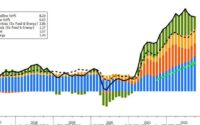US Debt Risks ‘Slow-Motion Collision’ With Fight Against Inflation
- Efforts to bring down inflation could collide with high debt loads, Goldman Sachs said.
- That comes as higher rates are already pressuring government balances via increasing interest costs.
- “This suggests the US and UK are the most obvious candidates for a duration risk premium repricing.”
Efforts to bring down inflation could collide with high debt loads, a Goldman Sachs warned, highlighting the implications for US debt.
In a note published Monday, analysts looked at developed economies like the US, Japan, Europe and the UK, and noted that higher rates, which have risen to battle inflation, are already pressuring government budgets via increasing interest costs.
As central banks deploy anti-inflation tools, including the Fed’s quantitative tightening campaign, they limit the ability for inflation to erode debt, Goldman added.
“Ultimately this risks a slow-motion collision between inflation targeting and high debt loads, where a loose fiscal stance skews inflation risk and thus interest rates to the upside until a fiscal correction arrests the process,” analysts George Cole and Sara Grut wrote.
Countries with a track record of higher inflation and limited willingness to tighten fiscal policy are most at risk of seeing this scenario play out, they added.
A combination of high inflation and deep deficits would also likely mean low investor demand for government bonds, and high foreign ownership of debt is another risk factor, Goldman pointed out.
“This suggests the US and UK are the most obvious candidates for a duration risk premium repricing,” the note said, referring to the compensation a bond trader requires for taking on the risk that rates will change during a security’s lifetime.
The note comes as the outlook for US debt is changing. Deficits are widening, and the federal government is set to overspend by $2 trillion in fiscal year 2023.
In one quarter alone, the Treasury Department issued $1 trillion in new T-bills. And with the Fed removed as a key buyer, the Treasury has had to attract money from other corners of the bond market, forcing it to lift rates.
Meanwhile, $7.6 trillion of US government debt is maturing in under a year, putting more pressure on rates.
[ad_2]
Source link


